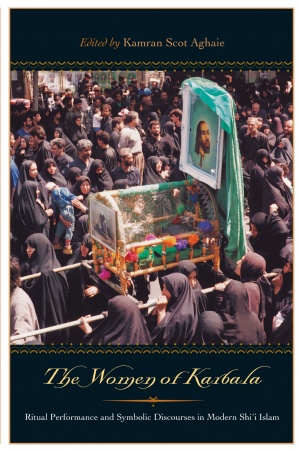The women of Karbala: ritual performance and symbolic discourses in modern Shi’i Islam
 | |
| Author | Kamran Scot Aghaie |
|---|---|
| Language | English |
| Genre | Historic |
| Published | 2005 |
| Publisher | University of Texas Press |
| Pages | 309 |
The book The women of Karbala: Ritual Performance and Symbolic Discourses in Modern Shi'i Islam focuses on the issue that women are not only involved in Karbala commemorative rituals, but also their presence in textual narratives and art plays is important.
About the author[edit | edit source]
Kamran Scot Aghaie (born December 8, 1967) is associate professor of Islamic and Iranian History at the University of Texas at Austin, and has served as director of the Center for Middle Eastern Studies and chair of the Middle Eastern Studies Department. His primary research interests are Islamic studies, Shi'ism, modern Iranian and Middle Eastern history. He is also interested in world history, historiography, religious studies, nationalism, gender studies and economic history. His main publications include the following:
- The Martyrs of Karbala: Shi‘i Symbols and Rituals in Modern Iran, Seattle: University of Washington Press, 2004;
- The Women of Karbala: The Gender Dynamics of Ritual Performances and Symbolic Discourses of Modern Shi‘i Islam, Austin: University of Texas Press, 2005;
- Rethinking Iranian Nationalism and Modernity: A Critical Re-evaluation; Kamran Scot Aghaie and Afshin Marashi (eds), Austin: University of Texas Press, 2014.
About the book[edit | edit source]
This book in 309 pages was among 100 best seller books of Amazon and about 4,282,666 copies of it have been sold.
The present book is about Karbala, the emergence of Shi'ism, gender and its limitations and acceptances, the development of Shiite symbols and religions in Iran and other parts of the world, including the Arab world, South Asia and the United States. It is divided into two main parts and 11 chapters in which different authors discuss some aspects as to how Shiite women are affected by or participate in a "Taziya", and about how Karbala event influenced the social and political lives of Shiite women around the world. They argue that the presence of Shiite women in the Muharram mourning rituals is different from the presence of other women in other religions. Moreover this presence in the same Shiite culture varies from community to community.
Abstract of chapters[edit | edit source]
Part 1: Iran[edit | edit source]
- Ta'ziya: A Twist of History in Everyday Life, in this chapter Negar Mottahedeh analyzes the ritual of Taziyeh and the importance of the role of women in this theatrical ritual during the Qajar period.
- The Gender Dynamics of Muharram Symbols and Rituals in the Latter Years of Qajar Rule, in this chapter Kamran Scot Aghaie deals with the issue of gender and its social, psychological and spiritual dimensions in Shiite religions in the Qajar period in Iran and how the dynamics and symbols served to restrict female behavior in certain ways.
- ‘‘Oh, My Heart Is Sad. It Is Moharram, the Month of Zaynab’’: The Role of Aesthetics and Women’s Mourning Ceremonies in Shirazin this Chapter Ingvild Flaskerud discusses the religious role of women in modern Shiraz and how they participate in such ceremonies and aesthetic drawing of Muharram mourning of women in modern Shiraz.
- The Daughters of Karbala: Images of Women in Popular Shi'i Culture in Iran, in this Chapter Faegheh Shirazi discusses about different aspects of female personality in the text of lamentations, songs and slogans of mourning ceremonies in Iran.
- Iconography of the Women of Karbala: Tiles, Murals, Stamps, and Posters, in this Chapter Peter J. Chelkowski considers the image of female model characters such as Zaynab and Hussein's wife in Shiite religious stories. He believes that these images have had an impact on the modern political world and its appearance.
Part 2: The Arab World, South Asia, and the United States of America[edit | edit source]
Sakineh, The Narrator of Karbala: An Ethnographic Description of a Women’s Majles Ritual in Pakistan, in this Chapter Shemeem Burney Abbas explores how the events of Karbala were narrated by a Shiite woman narrator in women's mourning rituals in Pakistan.
Sayyedeh Zaynab: The Conqueror of Damascus and Beyond, in this chapter Syed Akbar Hyder deals with South Asia and what is presented there as religious practices and shows the focus of the text of laments and hymns on Sayyedeh Zaynab.
Gender and Muharram Rituals in an Ismaili Sect of South Asian Muslims, in this Chapter Rehana Ghadially analyzes one of the manifestations of Ismaili Shiism in the Bohra community of India. She talks about the activities of men and women in Muharram ceremonies and the issue that presence of women depends on the type of ceremonies (private or public).
Women of Karbala Moving to America: Shi'i Rituals in Iran, Pakistan, and California, in this chapter Mary Elaine Hegland compares the two major Shia immigrant communities in the USA: Iranians and South Asians. She shows that they have completely different and separate religious practices and rituals, which are based on their experiences in political and religious dimensions.
Women’s Religious Rituals in Iraq, in this Chapter Elizabeth Warnock Fernea and Basima Q. Bezirgan study public and private space, the masculine and feminine worlds and the relationship between the two. They show the supportive role of both sexes in Ashura rituals in Iraq as well as in other areas of Middle Eastern societies.
From Mourning to Activism: Sayyedeh Zaynab, Lebanese Shi'i Women, and the Transformation of Ashura, in this Chapter Lara Z. Deeb deals with the issue of Shiite mourning ceremonies in Lebanon and the changes caused by urbanization and modernization. The author refers to Zaynab's role in Karbala and her role model in present time.